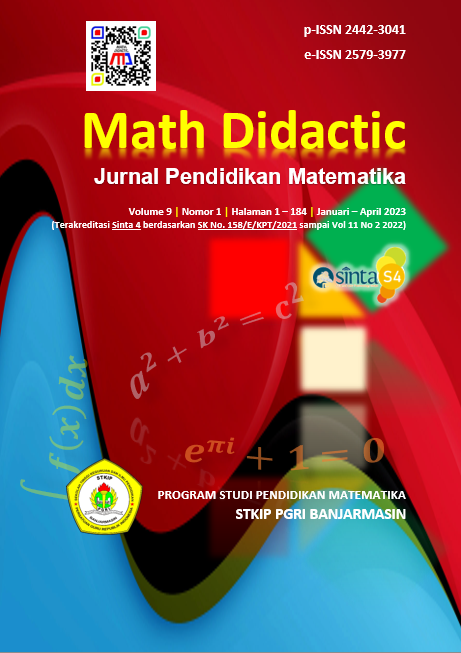The culture transformation: situs Gambyok in mathematics teaching learning with pancasila student profile
Sebuah transformasi budaya: situs Gambyok dalam pembelajaran matematika berprofil pelajar pancasila
Abstrak
This article aims to describe the transformation of the knowledge process, namely the gambyok site into an indicator of mathematics learning tools with a Pancasila student profile. The research used is descriptive qualitative research. The instrument is an interview sheet that is used to gather information from cultural actors, mathematical concepts, learning outcomes and learning objectives (ATP). Transformation process data obtained from interviews with informants, cultural actors studied by collecting information by translating interview scripts, data reduction by classifying information that is relevant to what is needed in such a way that the transformation process variables can apply to the indicators indicator . The results shown in this article are indicators that can be used to develop mathematics learning tools with a Pancasila student profile.
##plugins.generic.usageStats.downloads##
Referensi
Barton, B., & Frank, R. M. (2001). Mathematical Ideas and Indigenous Languages. Sociocultural Research in Mathematics Education: An International Perspective., 135–140.
D’Ambrosio, U. (1985). Ethnomathematics and Its Place in the History and Pedagogy of Mathematics. For the Learning of Mathematics, 5(February 1985), 44-48 (in 'Classics').
D’Ambrosio, U., & Rosa, M. (2008). Um diálogo com Ubiratan D’Ambrosio: uma conversa brasileira sobre etnomatemática. Revista Latinoamericana de Etnomatemática, 1(2), 88–110.
Fiantika, F. R., Budayasa, I. K., & Lukito, A. (2018). Internal process: what is abstraction and distortion process? J. Phys. Series, 983. https://doi.org/10.1088/1742-6596/983/1/012086
Fiantika, F. R., Sa’Dijah, C., Qohar, A., & Darsono. (2020). Link between modern building and Kediri’s tradition: An idea to develop teaching-learning equipment. Journal of Physics: Conference Series, 1470(1). https://doi.org/10.1088/1742-6596/1470/1/012001
Fiantika, F. R., & Setyawati, S. P. (2019). Representation, representational transformation and spatial reasoning hierarchical in spatial thinking. Journal of Physics: Conference Series, 1321(2). https://doi.org/10.1088/1742-6596/1321/2/022056
Fiantika, F. R., Sugianto, F. A., Jannah, H. N., Zhoga, E. F. E., Junior, F. A., & Perdani, C. W. (2021). Abstraction mathematics concepts: Learning innovation based on heritage culture during the pandemic COVID-19 era. Journal of Physics: Conference Series, 1918(4). https://doi.org/10.1088/1742-6596/1918/4/042094
Kemendikbudristek. (2022a). Kurikulum Merdeka. Direktorat Pendidikan Dasar. https://ditpsd.kemdikbud.go.id/hal/kurikulum-merde
Kemendikbudristek. (2022b). Profil Pelajar Pancasila.
https://ditpsd.kemdikbud.go.id/hal/profil-pelajar-pancasila
Kemenparekraf. (2020). Situs Gambyok. https://direktoripariwisata.id/unit/8317
NRC. (2010). Learning To Think Spatially. The National Academies Press (U.S.). www.nap.edu
Saichu, A. (2022). Bentuk Gugus Tugas Gerakan Revolusi Mental, Wali Kota Kediri Raih Penghargaan dan Apresiasi Dari Mendagri. Koran Memo. https://www.koranmemo.com/daerah/pr-1924009085/bentuk-gugus-tugas-gerakan-revolusi-mental-wali-kota-kediri-raih-penghargaan-dan-apresiasi-dari-mendagri
Thiagarajan;, Sivasailam;, & Semmel. (1974). Instructional Develoment for Traning Teacher of Exeptional Children: A Sourcebook (p. 194). National Center for Improvementof Educational System (DHEW/OE).
Turmudi. (2007). Prosiding Seminar Nasional Etnomatnesia KAJIAN ETNOMATEMATIKA: BELAJAR MATEMATIKA DENGAN MELIBATKAN UNSUR BUDAYA (*) Oleh: Turmudi. 38–53.
Tversky, B. (2007). Pictorial Representations in Adults and Children. Quarterly Journal of Experimental Psychology, 31(3), 397–408. https://doi.org/10.1080/14640747908400735
Tversky, B. (2014). On Abstraction and Ambiguity. Studying Visual and Spatial Reasoning for Design Creativity, 215–223. https://doi.org/10.1007/978-94-017-9297-4_13
Ubiratan D’ambrosio. (1985). FLM Publishing Association Ethnomathematics and Its Place in the History and Pedagogy of Mathematics. Source: For the Learning of Mathematics, 5(1), 44–48.






















